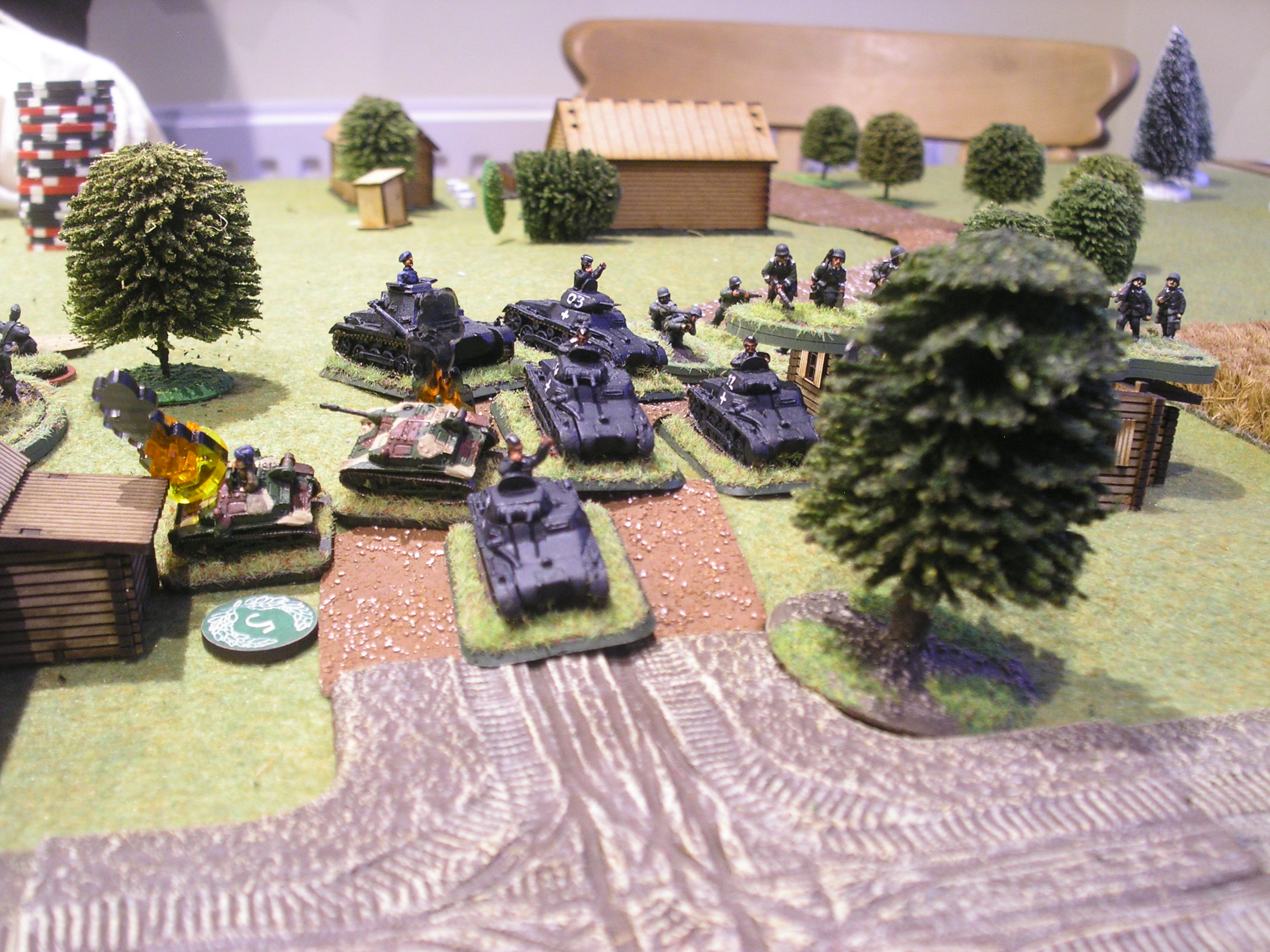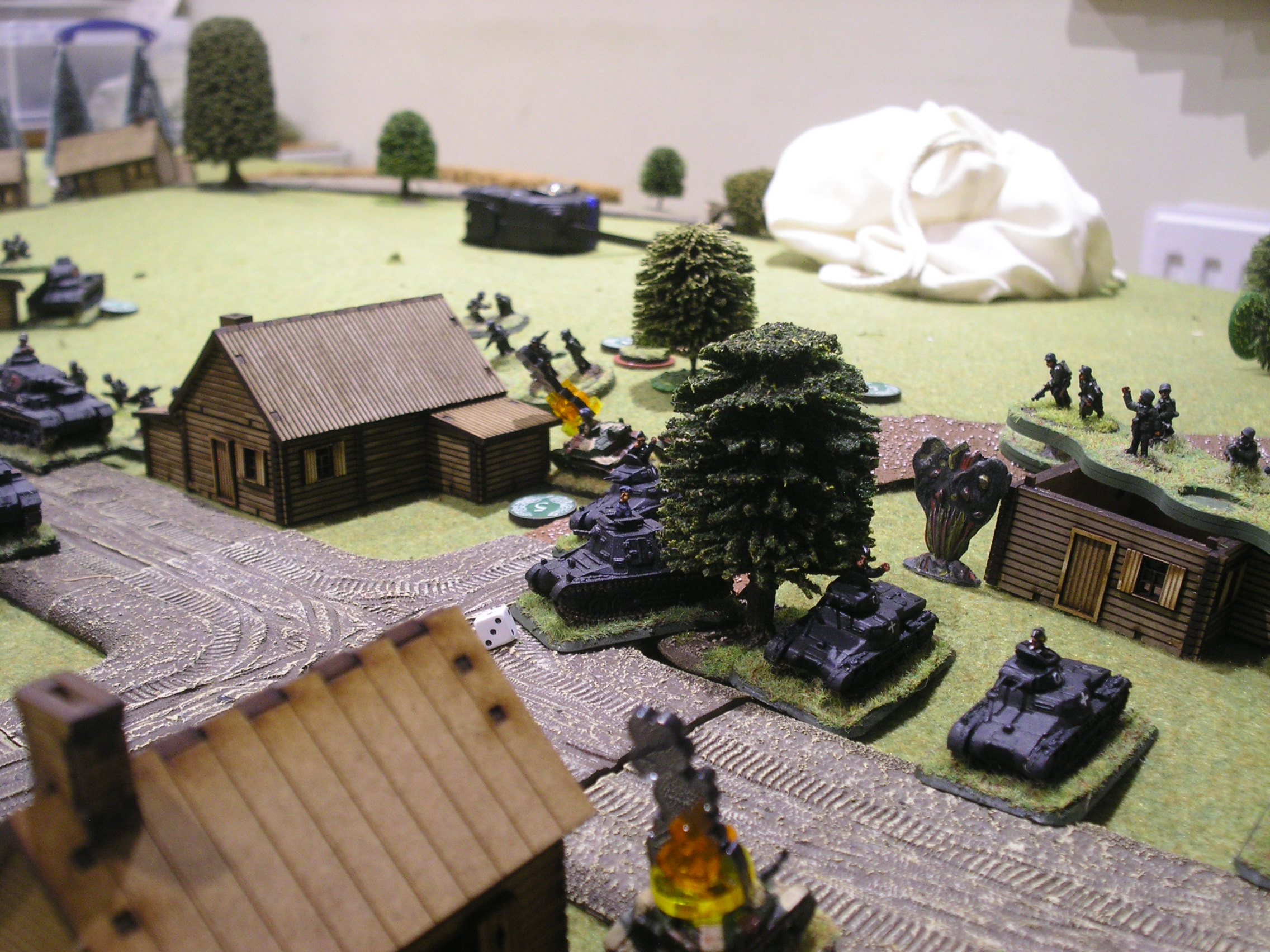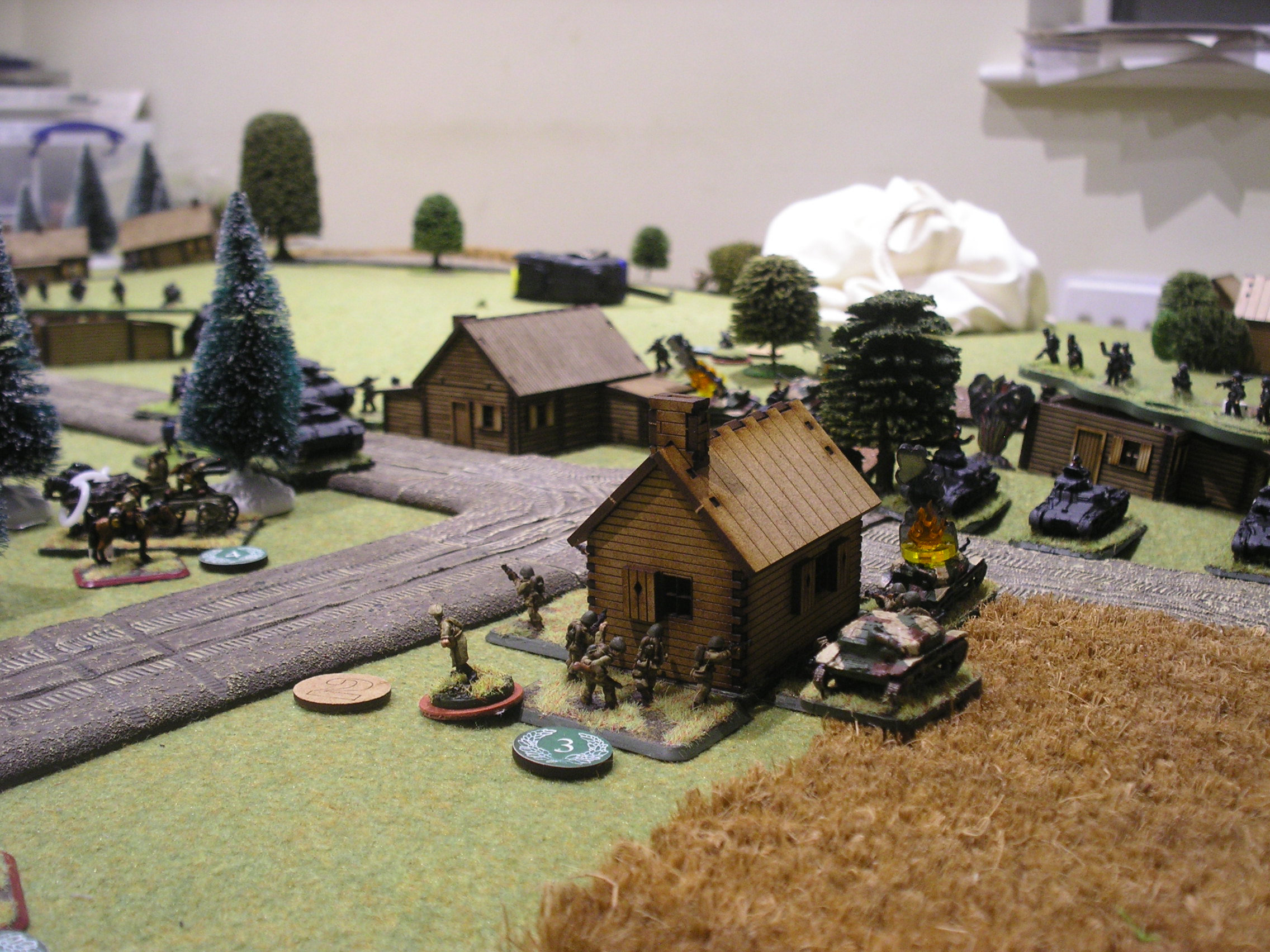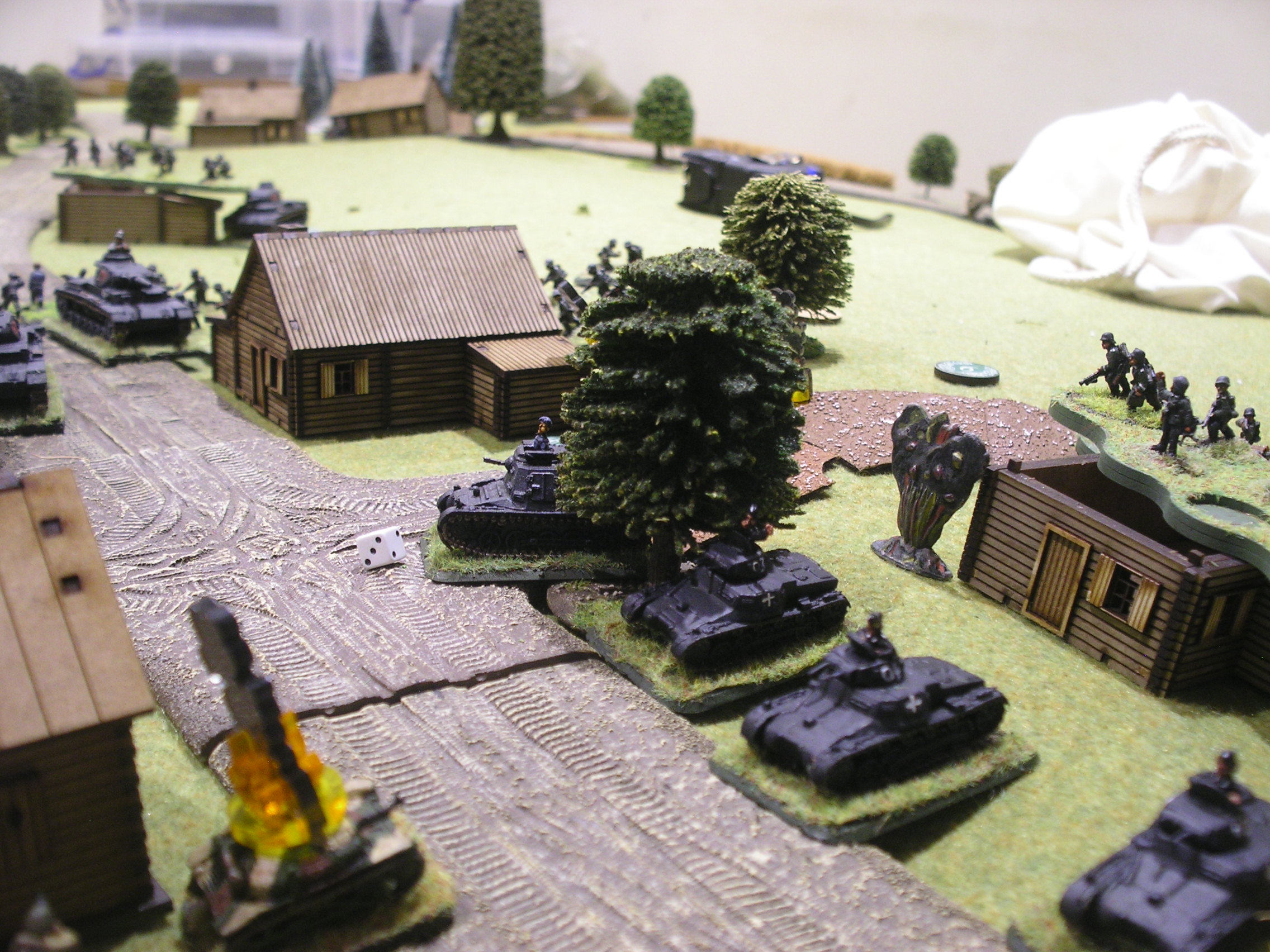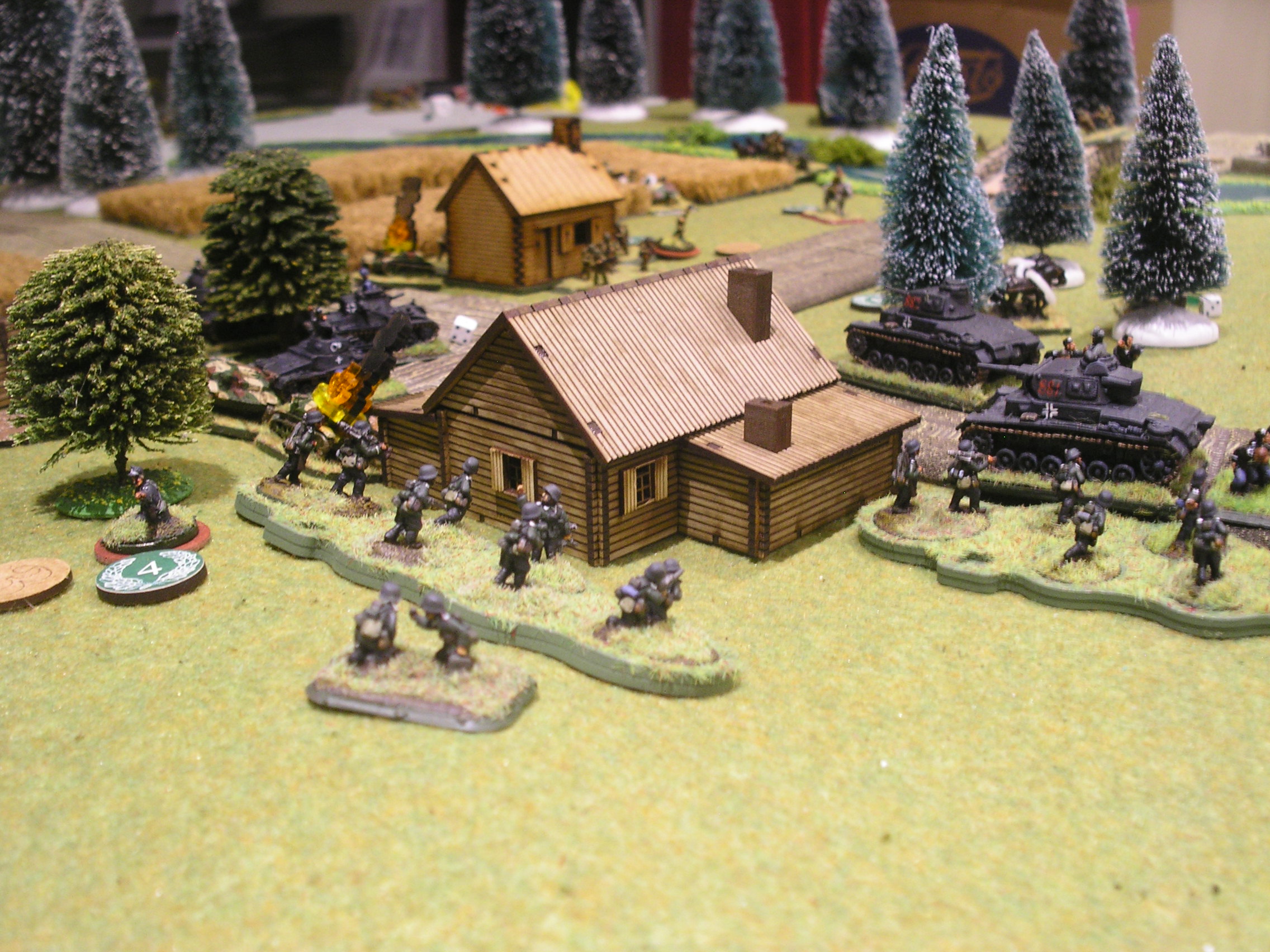On September 7th 1939, reconnaissance units from one of the Panzer Divisions of General Nikolaus von Falkenhorst’s XXI Army Corps captured Wizna after Polish mounted reconnaissance squads abandoned the village after a short fight and retreated to the southern bank of the Narew. When German tanks tried to cross the bridge, it was blown up by Polish engineers.
This game would recreate the German attempt to force the Narew Crossing.
The Bridge over the Narew. Polish Blinds 6-8 are dummy Blinds that I was hoping could move forward and spot the Germans nice and early. Everything else is hidden, apart from Blinds 2 and 4, whom I was aiming to send across the bridge to secure it from the other side.
The picture above shows the bridge in question, along with the surrounding terrain. The German deployment area can be seen top right.
The four Polish eagle markers (well, three are visible) mark out the Polish deployment area. They would be removed before the first chit was pulled.
The game was a screening mission. Provided the bridge remained in Polish hands (i.e. no German troops were in base-to-base contact with the bridge) each time the Turn Card appeared, Polish engineers would roll a D6. Once the total rolled hit 25, any Polish Big Man could order the bridge blown.
The Poles
The Poles, defending, had:
a platoon of two 12-man dismounted border guard (KOP) cavalry squads
a platoon of two 12-man KOP infantry squads
three taczankas (a machine gun mounted on a custom-built cart)
two anti-tank guns from division
five TKS tankettes.
These last were unfortunately armed only with a machine gun rather than being the rarer variant upgunned with a 20mm cannon.
The Germans
Did I mention that the Germans also had air support and off-table mortars?
The Germans fielded:
a company of motorised infantry: three platoons, each of three 8-man squads, with each squad carrying two support weapons i.e. firing on four dice not the usual three
a platoon of four MMGs
an infantry gun platoon of two 75mm IGs
a platoon of five Panzer Is
a platoon of three Panzer IIIs.
This all looked quite formidable, especially as I was playing the Poles…but it was no good complaining as I had written the scenario: #12 in the first September War scenario pack.
Opening Moves
The German advanced forward under Blinds, deploying onto the table as they encountered my line of dummy Blinds. One platoon of German infantry (second platoon) advanced along the right hand side of the main road, another (first platoon) advanced along the left hand side of the same road accompanied by the Panzer IIIs. The rest of the German force moved up behind.
I decided to open fire as soon as possible, hopefully taking advantage of the long distance that the Germans would have to cover to get to me.
This was a plan which had mixed success. Although the fire from one taczanka and one tankette sent the German infantry scurrying for cover, slowing down their advance, the lead Panzer III opened fire on my tankette and, despite its low profile, hit it with a 37mm shell that blew the little tin can to bits!
I wasn’t entirely without a bit of luck, however. By this stage, the Turn Card had already appeared twice, with me rolling a “6” each time: 25 points needed, 12 on the scorecard already!
Long range exchange of fire continued on for a couple of turns, until Bevan, playing the Germans, realised that he had no hope of winning the game at this distance, and would need to get up close and fight his way through to the bridge the hard way!
The Germans Drive Forward
I had now revealed most of my assets and was busy laying down as much fire as possible.
Recognising the fact that the north side of the village was effectively held only with a tankette and an anti-tank gun, the Germans sent their third platoon in a dramatic rush forward across open ground in an attempt to get a foothold amongst the wooden houses.
As the same time, two of the German Panzer IIIs used their Blitzkrieg bonus moves to close with the taczanka, anti-tank gun and tankette in the small wood just south-west of the crossroads.
This turned out to be a very risky move, as although lots of damage was done to all the Polish units in the woods, both Panzer III crews were eventually forced to abandon their vehicles: Shock and accumulated damage causing a loss of nerve.
Meanwhile, the German infantry north of the village had managed to get in amongst the first house, although crossing the open ground had cost them a whole squad. Unfortunately for the Poles, at this moment the Panzer Is appeared. Having been lurking off-table for the game so far, they now arrived and also slammed into the village from the north.
As you’ll see from the pictures, above, the situation was now desperate. The only things holding the Polish position together were three Big Men (Kapitan Nalewki, Porucznik Kielbasa and Sierzant Czworniak) the last anti-tank gun, the two taczankas, a couple of tankettes and a squad of infantry holding the house in the centre of the village. These had taken cover at the far end of the house, so that although the Panzer Is were hammering the north end of the house with their machine guns, the squad remained fairly intact. They would have to be removed by infantry.
The German third platoon charged forward, but one of its squads and its leader, Leutnant Fabian Fastnachts (his brother, Freddi, was commanding second platoon), got tangled up in the Panzer Is and didn’t make it into contact. That left about fifteen Germans versus about ten Poles, but the Poles were defending what was left of the wooden hut. After fierce fighting, the Germans were repelled with 35% casualties.
The Turn Card had appeared another couple of times, and the Polish engineers had now achieved 21 of the 25 points needed in order to blow the bridge. The Germans could stop that total going up if they could get into base-to-base contact with the bridge, so whilst his infantry sorted themselves out, Bevan sent his Panzer Is in a sweep through the village in the hope that one of them might make it onto the bridge and survive for long enough to let the rest of his force catch up - after all, second platoon had eventually got moving and, covered by the fact that the Poles had their hands full dealing with the Germans coming from the north, managed to get into the wood near the church near the bridge.
Climax
Down through the village swept the Panzers, bypassing the Polish infantry and heading for the last remaining anti-tank gun (now down to two crew members) and taczanka.
Two of the Panzers were taken out by the anti-tank gun, one of them by the single crew member remaining, but the third tank managed to avoid getting hit and ran over the anti-tank gun, mangling it into the ground. Incredibly, the Panzer I avoided throwing a track as well.
Apologies for the poor focus in the pictures, below, but things were unbelievably tense and photography was actually the last thing on my mind. The Poles were still holding the bridge…but where on earth was that blasted Turn Card?
Neither side had much left to play with now, but still the Germans advanced, desperate to get something onto the bridge to “stop the clock”. The photo below shows the situation from Polish final position.
Where was the Turn Card? It had been due out for several turns. All we had had was a rapid succession of Tea Break cards that had intensified the close range fighting for the village.
The Germans had one last trick up their sleeve. They had two tanks left: a Panzer I and a Panzer III. The Panzer I leapt forward and rammed the Poles’ last remaining taczanka. It threw a track and immobilised itself in the process (its crew abandoning ship) but, most importantly, had now taken out the last remaining Polish unit that could seriously threaten an AFV. Yes, the Poles still had infantry left, but they weren’t used to fighting tanks, and had an anti-tank factor of only 1: someone had obviously misplaced the regimental can openers!
That left the last remaining Panzer (a Panzer III) free to drive forward onto the bridge itself, scattering the Polish engineers still setting their charges. Although we did have a quick debate as to whether the Panzer counted as “troops”, I conceded that it probably did (Bevan: “well you tell me: you wrote the scenario!”), which meant that it now didn’t matter if the Turn Card appeared…or at least not until I had removed the tank.
And that, as they say, was that. After an unbelievably tense game, with the Poles fighting for every inch of the village, praying that their engineers (the Turn Card) would finish their job and blow the bridge, the battle ended in a German victory as I conceded that I wouldn’t be able to shift the tank and restart the clock, as it were.
Just to see what would happen, Bevan put his hand into the chip bag and pulled out the next chip. It was, of course, the Turn Card, arriving just a second too late for the Poles!
The game had been carnage on both sides. All the Poles had left in action was 26 infantrymen. The Germans had lost half their infantry and all but two of their eight panzers.
An amazing game of I Ain’t Been Shot, Mum whose result literally came down to the last minute of action.
Robert Avery


